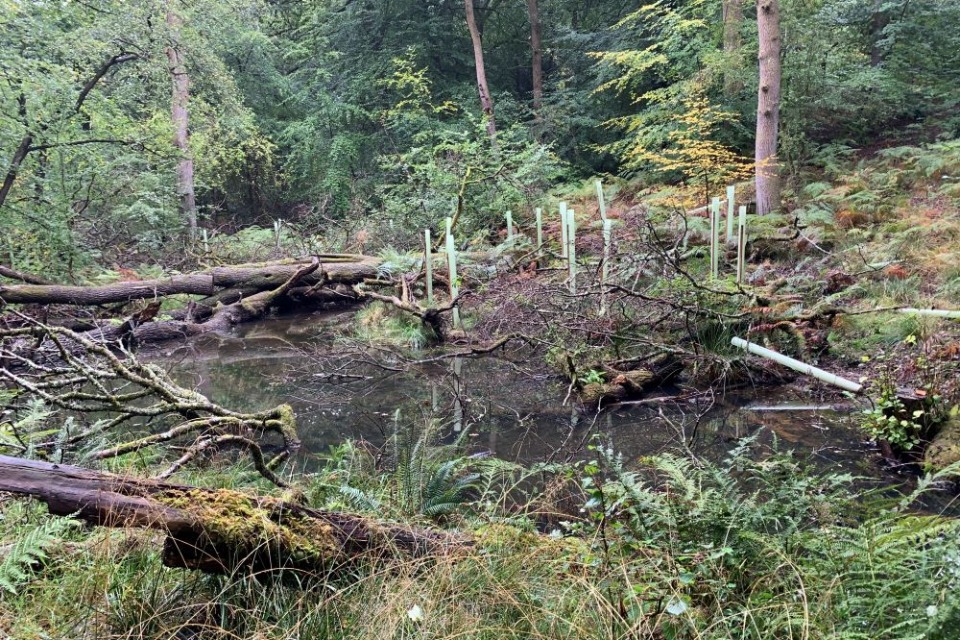As part of Flood Action Week, the West Midlands are being urged to plan ahead this autumn to reduce the impact flooding may have on their homes and businesses.
- Flood Action Week launches (13-19 October) promoting simple steps people can take to reduce the devastation caused by floods to their homes and businesses.
- Communities in the West Midlands warned not to be complacent about flood risk, despite continuing drought conditions in the region.
- Work led by Environment Agency to manage flood risk includes recently completed schemes in Bewdley and Worcester, natural flood management solutions and roll-out of property flood resilience measures.
In the West Midlands, more than 112,000 properties are at risk of flooding, with the UK experiencing more frequent and intense extreme weather due to climate change.
Despite continuing drought conditions in the region, people are warned not to be complacent about the risk of flooding. The dry conditions of recent months mean that the ground is hard and compacted, increasing the risk of localised surface water flooding.
Members of the public can:
- check their long-term flood risk using the Environment Agency's free service
- Sign up for flood warnings by phone, text or email
- Take steps to protect themselves from future flooding , including preparing a flood kit.
Work led by Environment Agency and its partners in the West Midlands to manage flood risk includes:
- recently completed schemes at Beales Corner in Bewdley and Toronto Close in Worcester; and progress on the Fowlea Brook Flood Risk Scheme in Stoke-on-Trent
- natural flood management (NFM) solutions, which are often used in rural areas
- roll-out of property flood resilience (PFR) measures.
Charlie Chandler, area flood risk manager for the Environment Agency in the West Midlands, said:
We know the devastating impact that flooding can have, which is why protecting people and communities is our top priority. We are working to reduce flood risk by using Property Flood Resilience, Natural Flood Management and schemes like the recently completed Beales Corner in Worcestershire. We urge members of the public to check their flood risk, sign up for flood warnings and to follow the advice to protect themselves from future flooding.
NFM uses natural processes to reduce the risk of flooding. These processes protect, restore, and mimic the natural functions of catchments, floodplains and the coast to slow and store water. Recent examples include river restoration in Gloucestershire, the installation of 'in ditch seepage barriers' on a farm in Herefordshire and woody debris dams in Worcestershire.

Leaky Woody debris which will slow the flow in Cannop.
PFR is a set of modifications added to a building to lower its flood risk. It can reduce flood damage and speed up recovery after a flood. The Environment Agency is supporting roll-out of PFR in locations across the West Midlands.
PFR case studies:
- In Marchington, East Staffordshire, PFR was installed in 12 properties. The PFR consists of flood barriers, airbrick covers and puddle pumps to remove water which can seep through floors and walls. Due to the age and design of these homes the barriers do not keep the properties completely dry, but they remain habitable. Previously, residents had to leave their homes for many months whilst repairs were carried out. Subject to the equipment being set up correctly, they can now remain in their homes. The village shop has put videos online showing how to set up the barriers and pumps: https://www.marchingtonshop.co.uk/training-videos .
- In Stafford, PFR will be installed in 33 properties. The PFR will consist of flood doors/barriers, airbricks, sealing pipes and cables plus more. This will better protect those properties that often flood during times of high river levels. The aim is to complete construction by the end of 2025.
NFM case studies:
In the West Midlands the Environment Agency are supporting councils through funding and advice on Nature Flood Management projects across the counties.
- In Gloucestershire, work is being delivered in Cannop catchment to slow the flow for Parkend, Whitecroft and Lydney. The project involves river restoration to increase channel storage, wetland creation, utilising leaky woody debris and more. The aim is to enhance 70km of watercourse and 10 hectares of habitat. This work is being carried out by Gloucestershire County Council and Forestry England.
- In Herefordshire, 'in ditch seepage barriers' have been installed on Jamie's Farm in Hereford. 'In ditch seepage barriers' work by slowing the flow of water from the land, resulting in a smaller volume of water. Tree planting has taken place too plus working with attenuation pools to slow the flow of the water to the brook. This work will reduce flood risk for Ewyas Harold and Dulas. This is one of five farms managed by the Jamie's Farm Charity which runs residential experiences for vulnerable young people, providing them with the opportunity to combine farming, family and therapy. The work was carried out by the charity and the Wye and Usk Foundation.
- In Worcestershire, ponds, scrapes and woody debris dams are being installed in the Kyre Brook catchment, this work will help reduce the flood risk in Tenbury Wells. This work is being carried out by Worcestershire County Council and Severn Rivers Trust.
- SVWM: The Severn Valley Water Management Scheme is a partnership between the Environment Agency, Natural Resources Wales, Shropshire Council, and Powys County Council. This strategy seeks to develop a holistic approach to flood risk management and explore how natural processes can be delivered at scale and complimented by traditional engineering approaches. This work will be carried out across the Upper Severn catchment, the 2,500km2 upstream of Shrewsbury, crossing the English and Welsh border.






